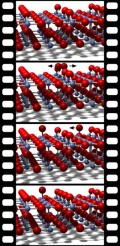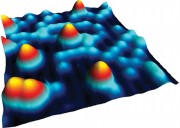This is an old revision of the document!
The Many Faces of Titania
Titanium dioxide (TiO2, titania) has an incredible variety of applications, as a photocatalyst, in dye-sensitized solar cells, in electronic elements (memristors, varistors), as a white pigment, in optical coatings, and in sun lotion to protect your skin against harmful UV radiation. No wonder that it took the leading role among all research on oxide single crystals!
Also the list of publications on TiO2 by Surface Physics Group leader Ulrike Diebold is pretty long - more than 6 dozen entries! So we can only mention very few of her results on this page.
How simple molecules adsorb
 Any material interacts with its environment via its surface, and one of the first things to understand is how molecules bind to the material when they come from the gas phase (adsorption). On rutile TiO2(110), it is well known that O2 molecules adsorb at oxygen vacancies and dissociate there, healing the vacancy by filling it and leaving a single oxygen adatom at the surface. It was only recently that we could first detect the precursor to this process by STM: An O2 molecule in the previous vacancy appears very faint in STM images, but then explodes into two separate adatoms. Thereafter, one of them jumps back into the vacancy.
Any material interacts with its environment via its surface, and one of the first things to understand is how molecules bind to the material when they come from the gas phase (adsorption). On rutile TiO2(110), it is well known that O2 molecules adsorb at oxygen vacancies and dissociate there, healing the vacancy by filling it and leaving a single oxygen adatom at the surface. It was only recently that we could first detect the precursor to this process by STM: An O2 molecule in the previous vacancy appears very faint in STM images, but then explodes into two separate adatoms. Thereafter, one of them jumps back into the vacancy.
Whereas O2 dissociates in a rather benign manner, dissociation of the chlorine molecule is a more hefty process: Already a decade ago, we have found evidence that Cl2 adsorbed on rutile TiO2(110) literally explodes, and the the Cl atoms fly apart by 26 Å, a long distance on the atomic scale.
Organic molecules
 Considering applications of TiO2 as a photocatalyst and in dye-sensitized solar cells, understanding adsorption of organic molecules on TiO2 is of paramount importance. One of the nicest results of these studies was finding out how catechol diffuses on a titania surface. This molecule does not simply hop from place to place, but always keeps one of it's “feet” on the ground, lifting the other “foot” by means of a hydrogen atom. Hydrogen allows the molecules to dance back and forward over the surface!
Considering applications of TiO2 as a photocatalyst and in dye-sensitized solar cells, understanding adsorption of organic molecules on TiO2 is of paramount importance. One of the nicest results of these studies was finding out how catechol diffuses on a titania surface. This molecule does not simply hop from place to place, but always keeps one of it's “feet” on the ground, lifting the other “foot” by means of a hydrogen atom. Hydrogen allows the molecules to dance back and forward over the surface!
Anatase
TiO2 comes in three different crystalline forms, rutile, anatase and brookite. Rutile is the stable form for macroscopic crystals, and therefore most of the previous work on TiO2, including everything described above, was on rutile surfaces. In practical applications, nanometer-sized crystals are often anatase; we have therefore started to study its surfaces. In contrast to rutile, the anatase TiO2(101) surface usually has no stable oxygen vacancies on the surface: O vacancies are below, so it's all different! Nevertheless, O2 adsorbed at the surface can interact with an O vacancy, and then a O22- (peroxo) species may replace an oxygen atom in the surface. See our papers (listed below) for details.
References
- P. Scheiber, A. Riss, M. Schmid, P. Varga, U. Diebold
Observation and destruction of an elusive adsorbate with STM: O2/TiO2(110)
Phys. Rev. Lett. 105 (2010) 216101 ⋅ full text - U. Diebold, W. Hebenstreit, G. Leonardelli, M. Schmid, and P. Varga
High transient mobility of chlorine on TiO2(110): evidence for “cannon-ball” trajectories of hot adsorbates
Phys. Rev. Lett. 81 (1998) 405-408 ⋅ full text - S-C. Li, L.-N. Chu, X.-Q. Gong, U. Diebold
Hydrogen bonding controls the dynamics of catechol adsorbed on a TiO2(110) surface
Science 328 (2010) 882-884 ⋅ full text* - P. Scheiber, M. Fidler, O. Dulub, M. Schmid, U. Diebold, W. Hou, U. Aschauer, A. Selloni
(Sub)surface mobility of oxygen vacancies at the TiO2 anatase (101) surface
Phys. Rev. Lett. 109 (2012) 136103 ⋅ full text - M. Setvín, U. Aschauer, P. Scheiber, Y.-F. Li, W. Hou, M. Schmid, A. Selloni, and U. Diebold
Reaction of O2 with Subsurface Oxygen Vacancies on TiO2 Anatase (101)
Science 341 (2013) 988-991 ⋅ ⋅Abstract with link to full text
* Please note: access to full text (PDF files) of some articles is restricted due to copyright reasons.
For more papers on TiO2 by our group (still far from all of Ulrike Diebold's papers on this subject), see our Publications page.


